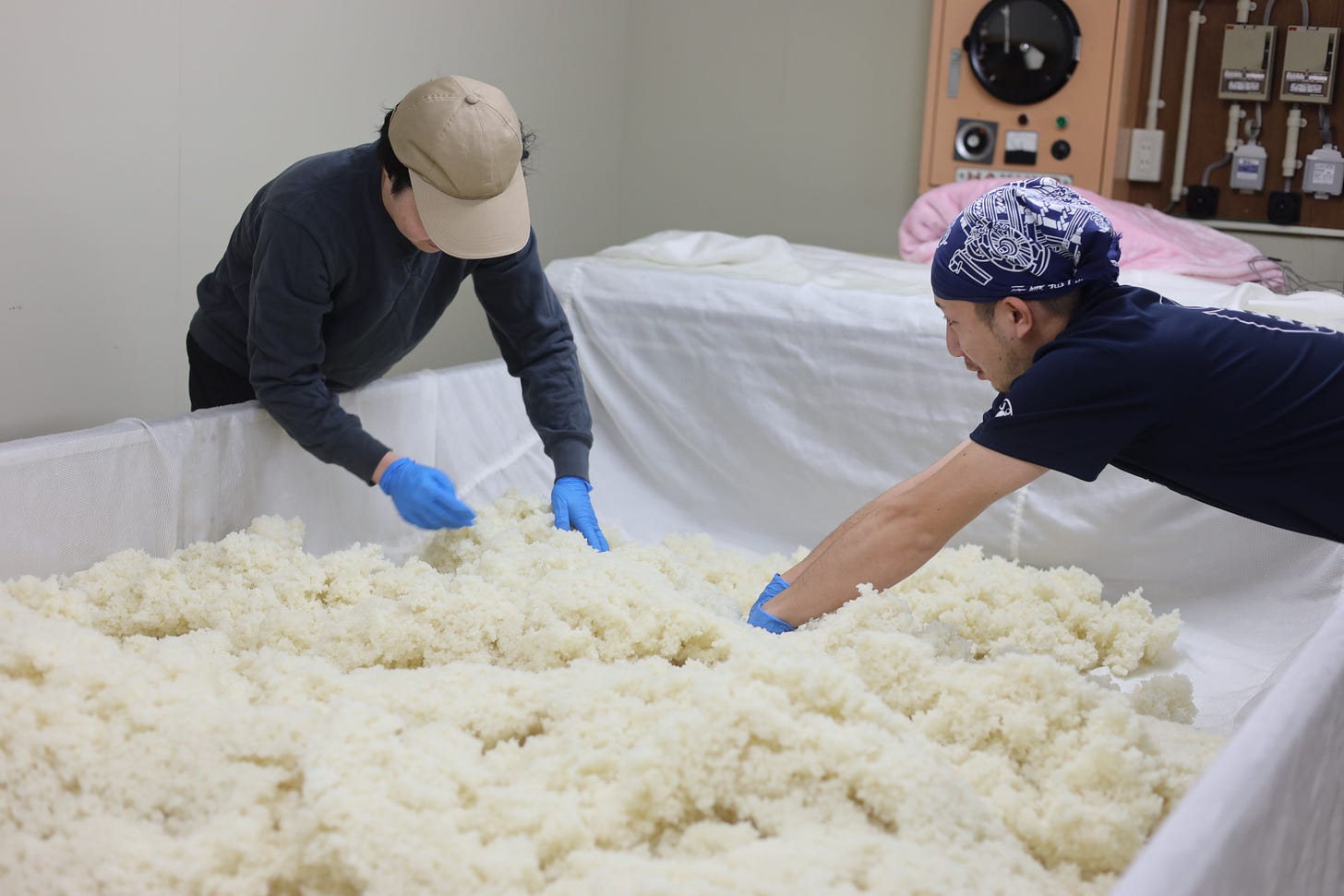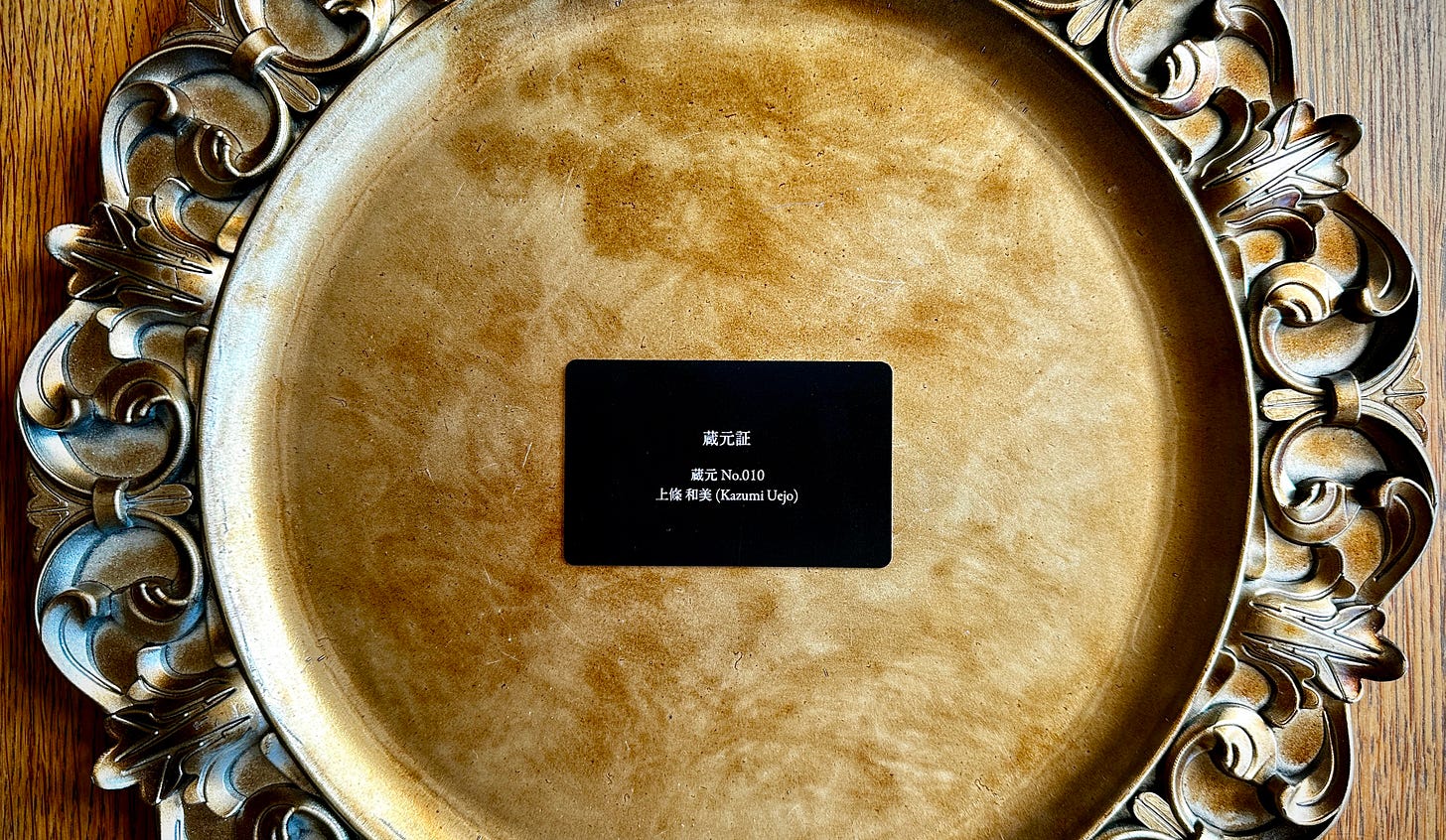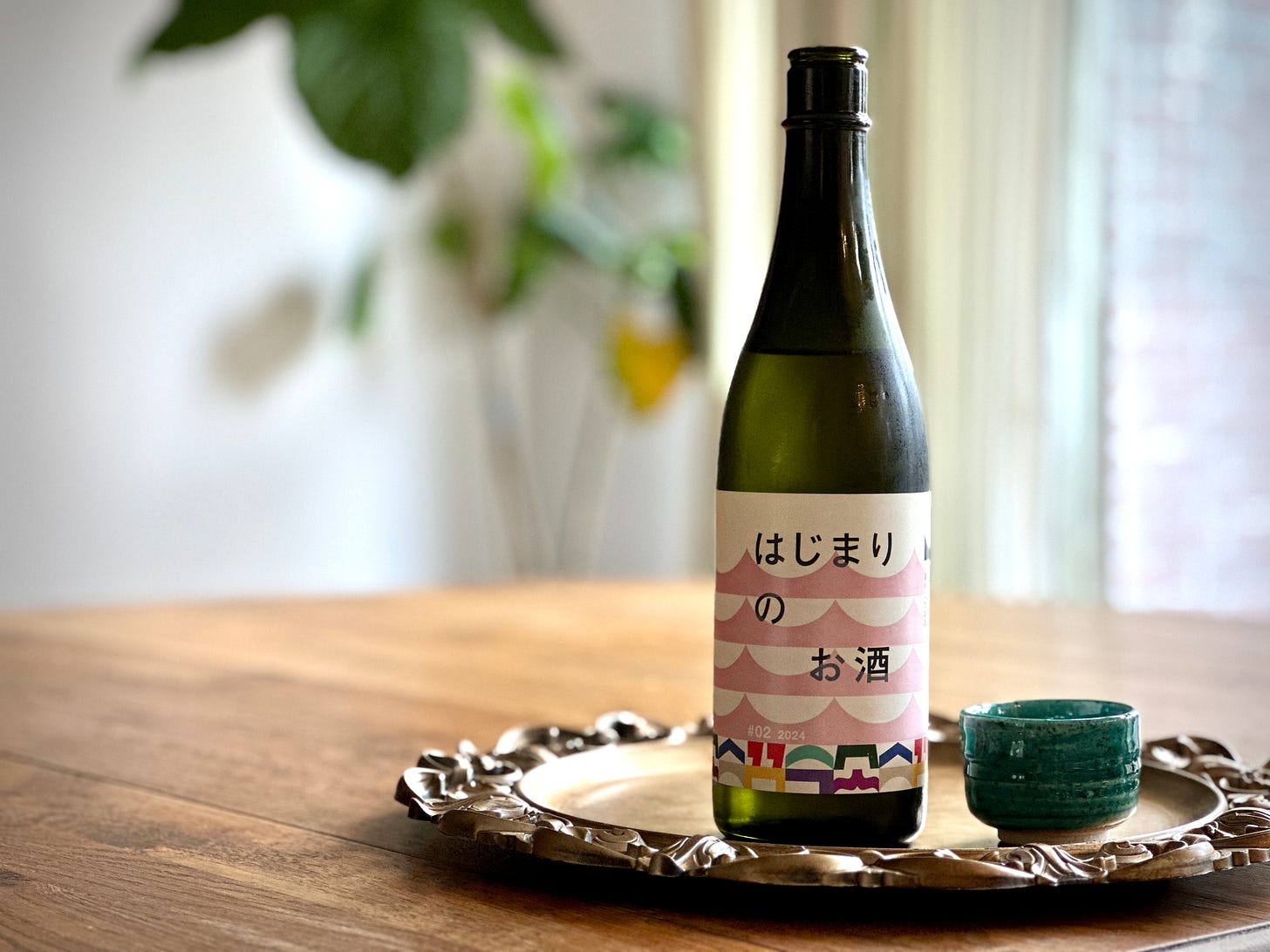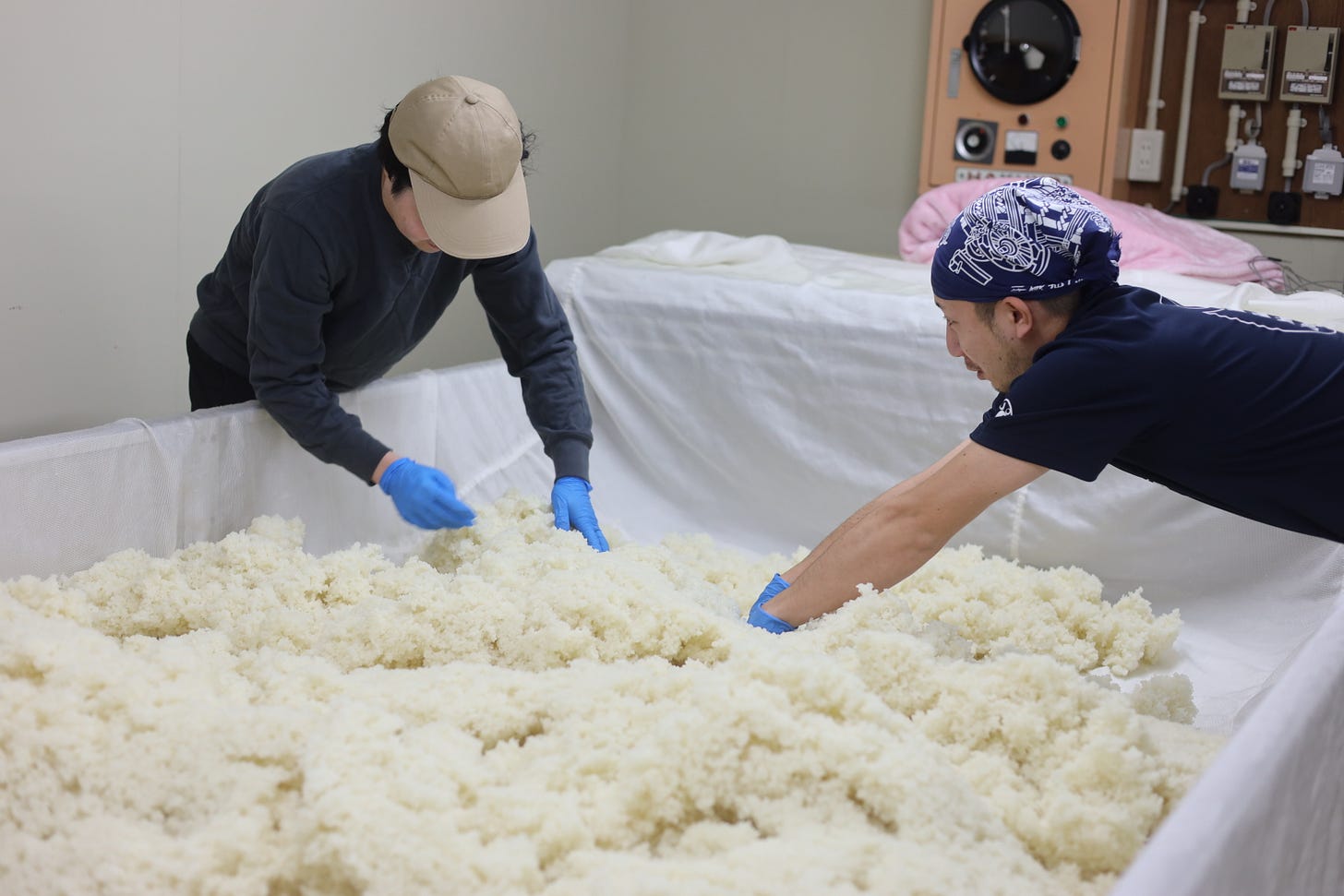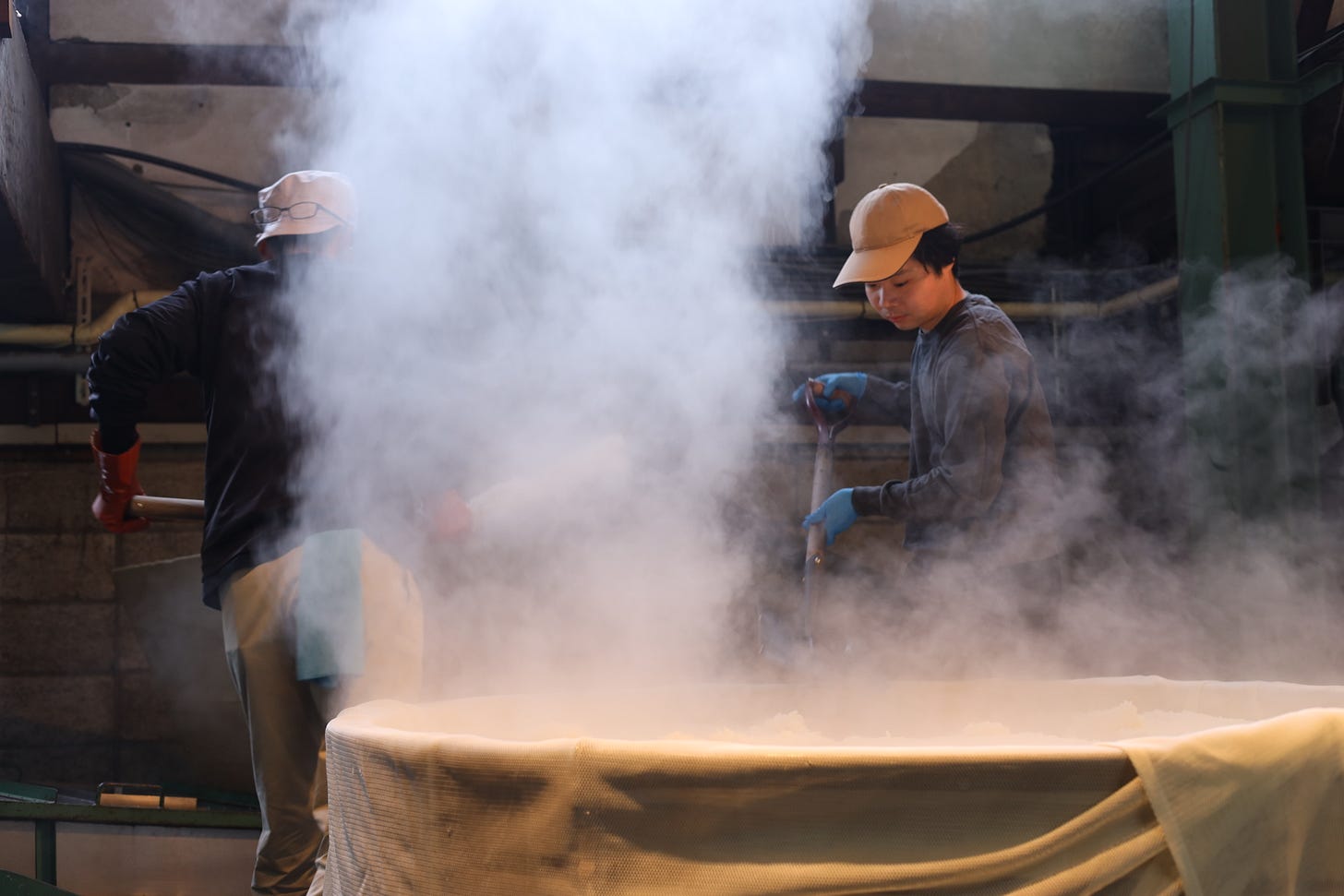Sake Interview #1: Hajimari No Osake
A personal interview with the brewer—and a look at sake through an investor’s eyes.
Introduction: Investing in a Town That Brews
Why this post matters for you today: If you work in wine retail or hospitality, this story will help you talk about sake with the same confidence and nuance you bring to wine. Not in the trade? You’ll still enjoy the journey (and maybe find a new favorite bottle). It bridges culture, technique, and tasting language—opening a door for you to connect with guests or friends in a new, memorable way.
Last year, I came across an ambitious sake project based in Shiwa, Iwate Prefecture, Japan—the birthplace of the Nanbu Toji brewing guild. (Traditionally, sake brewing was a seasonal occupation carried out by members of these guilds, with the Toji serving as the head brewer.) Drawn by the project's unique vision—to transform the entire town into a collective brewery—I became a small investor from Amsterdam, holding a share in a sake barrel I’ve never physically seen but deeply care about.
Recently, I had the opportunity to conduct an online interview with Yuto Kurosawa, the project’s founder, and Yudai Nagayasu, the head brewer. Yudai isn’t a hereditary sake master—he joined the project to become a Toji from scratch.
Yudai, also a passionate wine lover, brings a brewing philosophy that resonates strongly with wine enthusiasts. The sake he makes reflects that mindset: structured, elegant, and built to evolve across the palate like a fine wine.
In this article, I dive into the story behind this one-of-a-kind project, how a young brewer without a family background in brewing became a sake maker, his unique approach to the craft—and a tasting review of his very first creation.
Part 1: Hajimari no Osake Project – Brewing New Beginnings
Shiwa, a town nestled in Iwate Prefecture, holds a deep connection to sake history as the birthplace of the Nanbu Toji guild—one of Japan's most respected groups of master brewers. Yet today, Shiwa is becoming known not just for its legacy, but for its innovation.
At the heart of this transformation is the "Hajimari no Osake" project. Meaning "The Beginning Sake," this initiative aims to open the world of brewing to a wider group of people—not only in sake, but also in wine, craft liqueurs, and cider. Unlike traditional breweries often passed down through generations, this project invites diverse individuals—regardless of background—to step into the role of brewer, collaborator, investor, and more. The town’s vision is bold: to become a place where the entire community functions like a single, collective brewery. (Fun fact: One of the cider makers is an American couple who originally came to Japan to teach English.)
Each edition of Hajimari no Osake is crafted by multiple aspiring brewers. The brewers are mentored and supported throughout the process, giving them hands-on experience and a chance to translate their own philosophy into liquid form. It's an approach that challenges the idea that brewing must be inherited, suggesting instead that it can be learned, shared, and evolved.
Yudai Nagayasu joined this project as a first-time head brewer, bringing a structured and thoughtful mindset to his work. His contribution, Hajimari no Osake #02, reflects not only the project's experimental spirit but also his personal dedication to balance, precision, and evolving flavor architecture.
Part 2: Brewing by Design – Yudai Nagayasu’s Philosophy
According to Yudai, one of the key differences between wine and sake lies in the degree of craftsmanship involved. He emphasized that sake brewing, unlike winemaking, involves significant transformation by the hands of the brewer. While quality wine often highlights terroir and minimal intervention—even though meticulous care goes into expressing that terroir—sake requires precise control over each element to realize the head brewer’s vision. Each of elements in sake making is a deliberate choice, carefully made by the Toji to bring his vision to life.
That said, for Yudai Nagayasu, brewing sake is not about following a fixed recipe—it’s about guiding a living process. His approach starts with a conceptual "blueprint" of how he wants the final sake to taste: restrained, elegant aromas; a soft and sweet entry; a broad and savory mid-palate rich in umami; and a long yet refreshing finish framed by a touch of bitterness and acidity.
The essence of Japanese aesthetics lies here. In Japanese culture, beauty often resides in restraint. Minimalist precision rooted in character. A quiet confidence—it doesn’t shout, but it stands with clarity and inner strength. It’s full of character, just expressed in subtle ways. This sake reflects that cultural mindset—it’s calm, refined, and quietly powerful, like a well-composed haiku or a perfectly raked Zen garden. This is what I understood from his story.
But that vision is just the beginning. Each step—soaking the rice, selecting the koji mold and yeast, adjusting fermentation temperature and timing—is an opportunity for decision-making. Yudai describes it as a dance between intention and observation, where constant fine-tuning is required.
"I enjoy how sake gives me direct control," he explains. "It’s a process of responding to the material in real time, rather than letting nature take its course."
His background as a wine lover adds another layer to his thinking. He’s drawn to sake that can express itself across time on the palate—delivering a sequence of sensations rather than a single note. For Yudai, great sake, like great wine, must have inner structure, balance, harmony, precision, and progression.
Part 3: Elements of Philosophy
Rice, yeast, polishing ratio—all of these are elements that help bring Yudai’s vision to life. While they don’t define the sake alone, they reflect his values and decisions as a brewer. In true Sake 101 style, let’s take a closer look at these components.
Rice: 100% Yamada Nishiki, sourced from a contracted local farmer. In sake, rice is milled down to remove the outer layers, so its role as a terroir expression is minimal compared to wine. Still, quality matters. Intact grains, free of cracks and with ideal moisture levels, directly impact the brewing process. Yamada Nishiki is often called the "king" of sake rice for its large starch core and suitability for Ginjo-style brewing—low-temperature fermentation that allows extended control and yields elegant fruity aromas such as banana, apple, melon, lychee, and pineapple.
Polishing Ratio: 60%. Generally, the more the rice is polished, the lighter and more aromatic the sake. Less-polished sake tends to show more umami, structure, and mid-palate weight. A polishing ratio of 50% or less qualifies as Daiginjo, while up to 60% is considered Ginjo. This sake is Junmai Ginjo—pure rice sake with no added alcohol. It’s not highly polished, which allows more umami and texture to shine on the palate, rather than emphasizing fruity notes.
Yeast: "Yuuko no Omoi," a strain developed by the Iwate Brewers Association. It produces soft, warm, and elegant aromas—fruity, but never overpowering, even during low-temperature fermentation.
These choices offer a glimpse into Yudai’s blueprint. Restrained, elegant aromas; a soft and sweet entry; a broad and savory mid-palate rich in umami; and a long yet refreshing finish framed by a touch of bitterness and acidity.
But what does the final sake actually taste like?
Part 4: Tasting Hajimari no Osake #02
While technical details don’t define the experience, they offer clues to the flavor story.
Rice: 100% Yamada Nishiki
Yeast: Yuuko no Omoi
Polishing ratio: 60%
Alcohol by Volume: 14%
Recommended Serving Temperature: Chilled(6-13°C)
This sake is clear, pale lemon-green in appearance. The nose is clean, pure and restrained, showing delicate Ginjo aromas of apple, white peach alongside notes of ripe banana, and apricot, rice flour, steamed rice, bran, cotton candy, and sugarcane. A hint of grassy herbs adds a refreshing lift, while subtle fresh hazelnut brings another layer of complexity.
On the palate, it’s off-dry with medium-plus juicy acidity, medium-plus umami, medium alcohol (14%), and a medium-plus body. The flavors are concentrated and echo the nose, with a long, precise finish.
More expressive on the palate than on the nose, the attack is soft and sweet, with a slightly viscous, silky texture that coats the mouth. The mid-palate shows weight with umami, beautifully balanced by juicy acidity that’s higher than average for sake. The alcohol is well integrated and never distracting, even leaving a refreshing impression by its vibrant acidity that invites the next sip.
Texture, structure, and weight exist in harmony—an unfolding experience that mirrors Yudai’s vision of flavor architecture.
Conclusion: Sake for the Wine-Loving Mind
As of this writing, Yudai is deep into the brewing process for the 2025 edition of Hajimari no Osake #2. The original blueprint remains unchanged—but each year brings new refinements. The direction is consistent, but the sake becomes increasingly polished with experience.
One of the most striking moments in our conversation was when he reflected on what makes a sake “good.” From a wine lover’s point of view, some of the common criticisms of sake—such as its overly fruity aroma or lingering alcoholic heaviness—are precisely the things that fall outside his own definition of balance and quality. For example, He deliberately avoids aiming for showy fruitiness driven by ethyl caproate (green apple, melon) or isoamyl acetate (banana), as well as alcohol levels above 14%, which he feels can weigh down the palate with unnecessary heaviness.
Instead, he believes that texture, structure, and weight must exist in harmony—just as they do in great wines. Acidity plays a role too, but not as a dominant force. When malic or citric acid is overemphasized, it disrupts the equilibrium. True harmony, he believes, is the universal language of taste. It’s a philosophy that resonates.
The project will prepare for export. It’s clear that Hajimari no Osake isn’t just another sake brand—it’s a quiet revolution.
As someone who’s not only interviewed the brewer but also invested in the project, this sake feels deeply personal. It’s a barrel I’ve never seen, but one I’ve tasted—and believed in. It’s a reminder that when craft is approached with clarity and curiosity, wine and sake begin to speak the same language.
A sake that raises a question: when we pursue balance, texture, and structure—don’t wine and sake ultimately aim for the same ideal?
For those of us who love wine and are curious about sake, this project offers more than just a bottle to taste. It’s a living, evolving experiment in craft, culture, and connection.
✨ Curious? Drop a comment or hit Subscribe to join my weekly Sake 101 series—where I translate sake into the language of wine, one bottle at a time.
日本語で読みたい方へ(日本(語)に馴染みの少ないワインプロに向けて書いており、日本語は、AIを使って翻訳しています)
ワインのプロのためのSake 101:見えないけれど、味わえる樽の中へ
醸造家へのインタビューと、ワインラバーであり、当該酒蔵への出資者としての視点から見る日本酒
はじめに:酒を醸す町に投資するということ
今日この記事があなたに役立つ理由:
ワインの小売やホスピタリティ業界で働いている方にとって、このストーリーは日本酒について、ワインと同じように自信と深みをもって語るヒントになるはずです。業界の方でなくても、文化や技術、そしてテイスティングの言語をつなぐこの旅を楽しんでいただけると思います。きっと、印象に残る形でゲストや友人との新しいつながりが生まれるはずです。
昨年、私は日本・岩手県紫波町に拠点を置く意欲的な日本酒プロジェクトに出会いました。ここは、南部杜氏の発祥地として知られています。(かつて、酒造りは杜氏と呼ばれる頭領を中心に、酒造り集団によって季節労働として行われていました。)この町全体をひとつの酒蔵に見立てるというユニークな構想に惹かれ、私はアムステルダムからこのプロジェクトに出資し、まだ一度も目にしたことのない酒樽の一部を所有する出資者になりました。
先日、このプロジェクトを立ち上げた黒沢惟人さんと、杜氏である永安祐大さんにオンラインでインタビューする機会を得ました。永安さんは、家業として酒造りを継いだわけではなく、このプロジェクトに参加することでゼロから杜氏になった人物です。
彼はワイン愛好家でもあり、その酒造りの哲学はワインファンの心にも響くものです。実際に彼の造る酒にはその精神が表れています。構造的でエレガント、そしてワインのように口中で変化を見せる味わいが特徴です。
この記事では、このユニークなプロジェクトの背景、家業ではない若者がいかにして杜氏となったか、その酒造りへのアプローチ、そして彼の初めての作品のテイスティングについて紹介します。
パート1:「はじまりの酒」プロジェクト ― 新しい酒造りの幕開け
岩手県の紫波町は、日本でも有数の杜氏集団である南部杜氏の発祥地として、深い酒造りの歴史を持つ町です。しかし今、紫波町はその伝統にとどまらず、革新の町としても注目されています。
その中心にあるのが「はじまりの酒」プロジェクトです。名前の通り「はじまりの酒」、この取り組みは、酒だけでなくワインやクラフト酒、シードルなど、より多様な醸造の世界を開き、多くの人が関われるようにすることを目的としています。世襲制で受け継がれてきた酒蔵とは異なり、このプロジェクトは、背景に関係なく、誰もが蔵人、協力者、投資家として関われる場を提供しています。町全体がひとつの集合的な酒蔵のように機能するという大胆なビジョンを持っています。ちなみに、参加しているシードル醸造家のひと組は、英語教師として来日したアメリカ人夫婦だそうです。
各回の「はじまりの酒」は、醸造志望者によって造られています。彼らは指導とサポートを受けながら、実践を通じて自らの哲学を酒に込めていきます。これは、「酒造りは継ぐもの」というこれまでの考え方に挑戦し、「学び、共有し、進化するもの」という新たな価値観を提示しています。
永安さんは、このプロジェクトで初めて杜氏として挑戦しました。彼の造る「はじまりの酒 #02」は、実験精神だけでなく、味のバランス、精度、そして構造的な展開へのこだわりが詰まっています。
パート2:設計から生まれる酒 ― 永安祐大の哲学
永安さんによれば、ワインと日本酒の大きな違いのひとつは、「人の手による変容の度合い」だそうです。ワインはテロワールを活かし、なるべく手を加えない造りという表現に注目が集まります(テロワールを表現するために微細な管理が必要であったとしても)が、日本酒はすべての要素を杜氏が設計・管理して初めて完成するものという認識だといいます。酒米の浸漬時間、麹菌や酵母の選定、温度管理、発酵期間――あらゆる工程が杜氏の判断によって積み上げられていくのです。
とはいえ、永安さんにとって、酒造りはレシピに従う作業ではありません。あくまで「生きたプロセスを導くこと」。まず彼の頭の中には、理想の味の「設計図」があります。控えめでエレガントな香り、柔らかく甘い口当たり、旨味の広がる中盤、そしてほろ苦さと酸味で締めくくられる長く清々しい余韻。
ここに日本的な美意識が宿ります。日本文化における美しさは、しばしば「抑制」に見出されます。ミニマルでありながら、芯のある表現。主張は控えめでも、明確な意志を持つ。まるでよく練られた俳句や、美しく整えられた禅庭のように。この酒からも、そんな静かな強さと洗練が伝わってきました。
しかし、ビジョンだけでは酒は完成しません。米の浸漬から酵母の選定、発酵温度と時間の調整まで、すべてが「意図」と「観察」のバランスで進んでいきます。
「日本酒は、自分の手で直接コントロールできるところが魅力」と永安さんは語ります。「自然に任せるのではなく、素材の変化にリアルタイムで応える楽しさがあるんです。」
また、彼はワイン好きらしく、「時間の中で味わいが展開する酒」に魅力を感じるそうです。単一の風味ではなく、複数の印象が舌の上を通過していくような、日本酒であっても「構造・バランス・調和・精密さ・展開」を持つべきだという考えです。
パート3:哲学を形にする要素たち
米・酵母・精米歩合――これらは、永安さんの哲学を形にする重要な要素です。
ひとつひとつが、彼の考え方や判断を映し出しています。Sake101として少し説明します。
酒米: 地元農家と契約栽培した100%山田錦を使用。
日本酒では米の外側を削るため、ワインのようにテロワールの表現は小さいですが、品質は極めて重要です。割れのない、理想的な水分量を持つ米は、発酵全体の安定性に関わります。山田錦は大きな心白を持ち、吟醸造りに適しており、低温発酵でバナナ、リンゴ、メロン、ライチ、パイナップルなどの香りを生み出します。
精米歩合: 60%。
精米が進むほど軽やかで香り高くなり、あまり削らない場合は旨味や中盤の厚みが出ます。50%以下で「大吟醸」、60%以下で「吟醸」。この酒は「純米吟醸」に該当し、アルコール添加のないピュアな造りです。過度に削らないことで、旨味とテクスチャーをしっかり感じられる設計になっています。
酵母: 岩手県酒造組合が開発した「ゆうこの想い」。
華やかすぎず、温かみのある優しい果実香をもたらします。低温発酵でも香りが暴走せず、しなやかな酒質に貢献します。
これらすべてが、「抑制された香り、柔らかい入り口、旨味の広がる中盤、そして苦味と酸で締める清涼なフィニッシュ」という、彼の味の設計図を形にしています。
では、実際にどんな味がするのでしょうか?
パート4:「はじまりの酒 #02」テイスティング
技術的な情報は体験のすべてではありませんが、味の手がかりにはなります。
米: 山田錦100%
酵母: 優香の想い
精米歩合: 60%
アルコール度数: 14%
おすすめの温度帯: 冷酒(6〜13°C)
外観はクリアで淡いレモングリーン。香りはクリーンで繊細、りんごや白桃、完熟バナナやアプリコットに加え、米粉、蒸米、ぬか、綿菓子、サトウキビのニュアンスも。ほのかな草の香りとフレッシュなヘーゼルナッツが複雑さを添えています。
口当たりはオフドライ、ジューシーな酸(中強)、旨味も中強、アルコールは中程度(14%)、ボディも中強。香りと同様の風味が広がり、長く精密な余韻が続きます。
口に入れた瞬間は甘く柔らかく、やや粘性のあるシルキーなテクスチャーが広がります。中盤は旨味の厚みがあり、それを支えるジューシーな酸がバランスを整えます。
アルコールはよく溶け込んでいて重たさはなく、酸の活力が次の一口を誘います。
テクスチャー、構造、厚みが調和した展開。それはまさに、永安さんの「味の構築」そのものです。
結び:ワイン好きの心に響く酒
この記事を書いている現在、永安さんは2025年版「はじまりの酒 #2」の醸造の真っ最中です。設計図は変わりませんが、毎年その完成度は少しずつ磨かれていきます。
会話の中で印象的だったのは、「良い酒とは何か」という彼の考察です。ワイン愛好家の視点から見ると、日本酒のよくある批判点――たとえば低温発酵由来のフルーティな香りが強すぎる、アルコール感が残る――は、彼にとってまさに「バランスを欠く要素」なのだと言います。
彼は、カプロン酸エチル(青リンゴ、メロン)や酢酸イソアミル(バナナ)による派手な香りを狙わず、14%以上のアルコールも重たく感じるとして避けています。
彼にとって理想の酒とは、テクスチャー、構造、厚みが調和し、静かに語りかけてくるような存在。酸も大切な要素ですが、前に出過ぎるとバランスを崩すと考えます。
「本当の調和こそ、味の共通言語」。この哲学は、深く共鳴するものでした。
このプロジェクトは、輸出準備も進めています。
「はじまりの酒」は、ただのブランドではなく、小さな革命なのです。
造り手に話を聞き、同時に出資者として関わっている私にとって、この酒はとても個人的な存在です。まだ見ぬ樽。でも、味わい、信じた樽。クラフトに明確なビジョンと好奇心をもって向き合えば、ワインと日本酒は同じ言語で語り始める――そう気づかせてくれる酒でした。
バランス、構造、テクスチャーを追求するなら――ワインと日本酒は、結局、同じ理想を目指しているのではないでしょうか?
ワインが好きで、日本酒にも興味があるあなたへ。このプロジェクトは、ただ味わうだけの酒ではなく、文化と技術、そしてつながりを体感する生きた実験です。
✨ 興味が湧いたら、ぜひコメントや購読ボタンをクリックしてください!毎週更新の Sake 101 シリーズでは、ワインの言葉で日本酒をひと瓶ずつ、解き明かしていきます。
読んでくださってありがとうございます!
「Pairing the World: Wine, Sake, and More!」は、ワインと日本酒の世界をつなぐブログです。購読は無料です。お気軽にどうぞ🍶🍷
「日本酒やワインの魅力を、自分の言葉で伝えられるようになりたい、日本と海外の架け橋になりたい」そう考えて、英語で丁寧に書いています。この取り組みが、日本酒に関わる方々にとって「応援したくなる活動」だと感じていただけたら幸いです。





